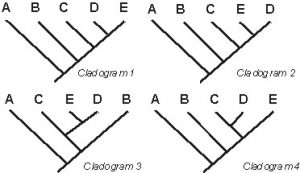How Plants Are Named
Part 1
By Mary Francis, Fairfax Master Gardener Intern

Portrait of Carl Linneaus
The publication of The Origin of Species by Charles Darwin in 1859 introduced the idea that living things evolve over the course of time through natural selection. Darwin convinced scientists that all living organisms were part of a single ‘family tree’ of life (a phylogeny). Taxonomists began not only to group like with like, but also to classify organisms in a way that reflects their evolutionary relationships, in other words using a phylogenetic classification.

Examples of Cladograms
There are several main reasons why taxonomists from time to time need, or choose, to change the name of a plant. A plant named by one botanist could have been already named by another. The naming of plants is covered by a set of rules — the International Code of Botanical Nomenclature (ICBM — which sets out how to correctly name plants and how to resolve cases where two or more names have been used for one species. In this case, the Code states that the plant will be given the earlier name.
Plant names can change based on new knowledge. Starting in the 20th century, scientists gained new information about plant deoxyribonucleic acid (DNA), and new ways to analyze their findings especially by using computers. Part two will explore these extraordinary new tests and their impact on how we now name plants.
References
• Upcoming Changes in Flowering Plant Family Names: Those Pesky Taxonomists Are at it Again!, Ellen
Dean, Fremontia, April 2002
• Why names change: the new thinking in taxonomy, Kevin Thiele, Western Australian Herbarium FloraBase,
May 2002
• Bioinformatics Approach in Plant Genomic Research, Quang Ong, Phuc Nguyen, Nguyen Phuong Thao, and
Ly Le, Current Genomics, August 2016